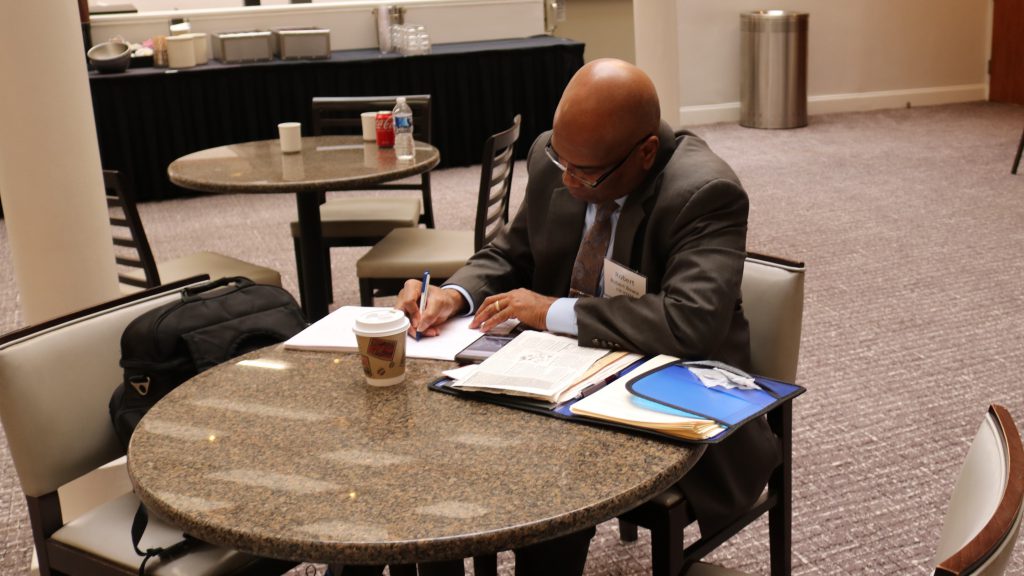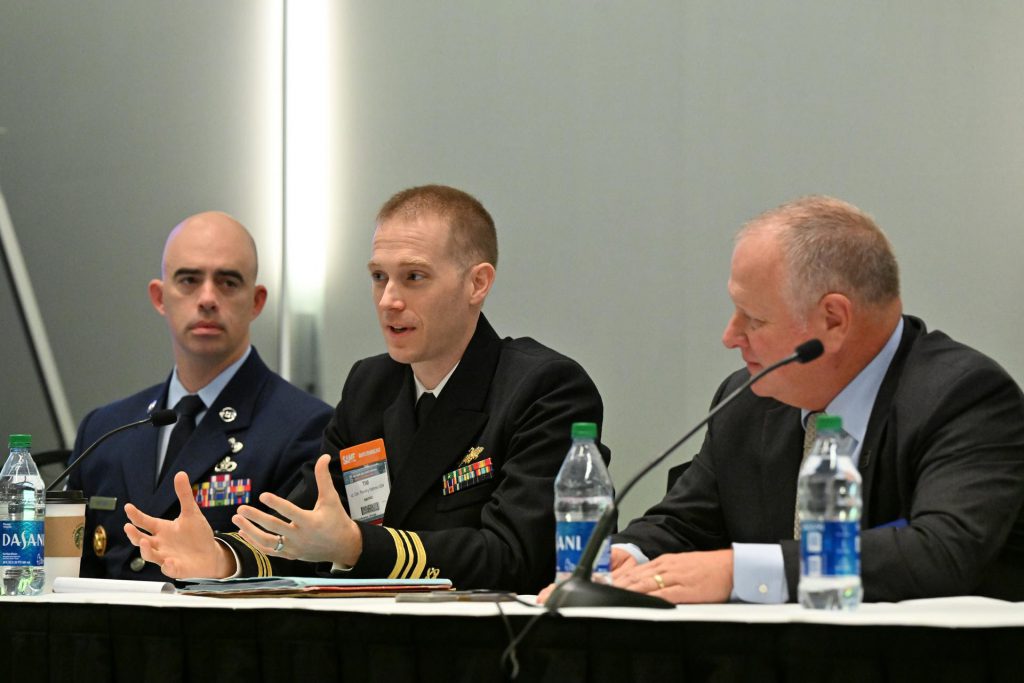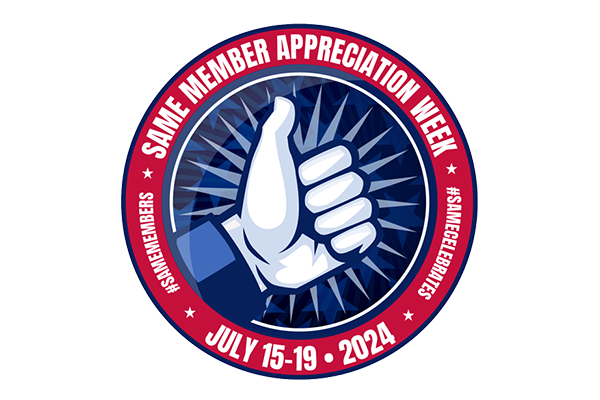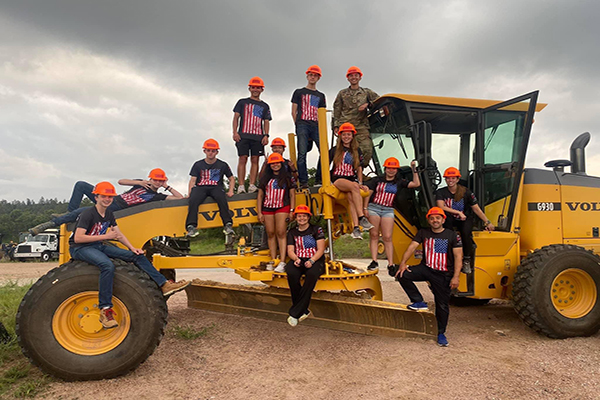Many members of SAME hold one or more professional licenses—everything from Registered Architect (RA), Certified Professional Services Marketer (CPSM), Project Management Professional (PMP), and, of course, Professional Engineer (P.E.). However, sifting through the variety of credentials available can sometimes be overwhelming. While acquiring a credential can open up new and better career paths for members, locating resources about where those career paths may lead isn’t always easy.
SAME has always supported credentialing for all its members, particularly Young Professionals and transitioning servicemembers. However, resources had previously been very disjointed across SAME and difficult to navigate for someone new to the industry or making a career transition. In 2020, the SAME credentialing program was rolled under the Young Professionals Community of Interest (COI). This group of passionate individuals has since been working to discover ways for the program to bring the most value to its members and aid in navigating many of the questions and uncertainties surrounding professional credentialing.
During the 2022 Small Business Conference, SAME sat down with Lt. Cdr. Tim Dahms, P.E., CEC, USN, Vice Chair for Credentialing; Willie Parks, RA, LEED AP, Assistant Vice Chair for Credentialing; and Victoria Mechtly, Immediate Past Chair of the Young Professionals COI, to talk about how the new Credentialing Committee is seeking to deliver value to members, how their own experiences with pursuing and gaining their professional credentials are influencing their vision for the committee, and the toolbox of resources the committee plans to make available to members later this year.
SAME: Two years ago, the Credentialing Committee was rolled under the Young Professionals Community of Interest (COI). What was the impetus behind that move?
MECHTLY: The move began as part of a bigger assessment by SAME National Leadership of the COIs and how different programs and initiatives fit into the communities. Before the move, the SAME Credentialing Program had struggled to get started, and the thought behind moving it under the Young Professionals COI was twofold. First, it made the most sense for us to take it over since Young Professionals are most likely the ones to be either pursuing or debating on credentials. Second, it allowed us to infuse the program with some of that Young Professional enthusiasm and energy and recharge it up.
We also wanted to take a different approach to the program. Rather than taking it on as a Community of Interest as a whole, we decided to focus our efforts on just providing resources. With the move under the Young Professionals COI, we wanted to make the program a member benefit and provide Young Professionals information to help them determine which credential to go after, how to go after it, and connect them with mentors who can provide more advice.

SAME: As you began transitioning this program under the Young Professionals COI, did you find any gaps in the existing program? And if so, how are you planning on addressing them?
DAHMS: Out of the gate, we identified that the existing program had been focused just on Young Professionals and Enlisted members. However, if you’re coming out of the military after 20 years, you’re right at that 39-40 age limit to be counted as a Young Professional. Ultimately, it’s not just Young Professionals who need this program—after all, some people get their college degrees when they’re 80! That’s why we felt it was easier to just expand it to everybody and make it a Society-wide benefit.
We also looked at the CAP program. This was previously the Credentialing Achievement Award Program (CAAP), which we decided to rename the Credentialing Assistance Program (CAP) to better reflect its purpose. Originally, the program was a means to provide reimbursement for test fees, but many firms and services provide this to their employees already. We thought to expand it to provide for study materials or references as well and fill that gap that companies or Society membership aren’t already covering.
Our vision is to create a one stop shop for credentialing resources, but we didn’t want to duplicate efforts either. Rather than creating a bunch of new material, our goal is to build a portal able to connect you to existing material. Not only would this benefit current members, but it would also help attract future members and showcase how SAME is the platform that helps get you to where you need to go.
MECHTLY: I’d also say the previous Credentialing COI focused on “what” over “why”: what the credential was versus why you should be credentialed. So that was something we really talked through in the early stages of the program and what we wanted to achieve—for members to understand why you should be credentialed. It’s especially important since not all employers are encouraging their employees to pursue credentials and our team knows the value of getting credentialed first-hand.
PARKS: One of the other things along with “why” is “how”: how to go about getting your credential and connecting them with resources. Because I’m a self-starter, when I went through for my credential, it was easier for me to find that stuff, but there isn’t a whole lot available. You do have to do a lot of due diligence to find it.
“With the move under the Young Professionals COI, we wanted to make the program a member benefit and provide Young Professionals information to help them determine which credential to go after, how to go after it, and connect them with mentors who can provide more advice.”
SAME: Let’s talk about that why then. Tim and Willie, you both have a credential; Tim, you have a P.E., and Willie, you have an RA. What were your motivations in pursuing those credentials?
DAHMS: The Navy made it really easy for me—I needed my P.E. for promotion. I didn’t really give a second thought as to why I was doing it, I just went ahead and did it. But I also came out of a school where taking the FE (Fundamentals of Engineering Exam) while you’re still in undergrad was pushed. I just got out of grad school recently and it’s a totally different environment now. Taking the FE at the undergrad level, let alone getting your professional license, isn’t pushed as much, and so a lot of those students don’t understand why pursuing a credential is so important. That’s why what we’re doing here is paramount, especially for contractors working with the government. Qualification requirements and being able to find the right people with the credentials to bid on projects is crucial. And if people aren’t getting credentials, this makes it even harder.
MECHTLY: Being able to find the right people is so important. When I’m looking at new projects and new opportunities and building a team of professionals, those credentials are needed. The government is asking for them, as well as on the private side. It makes it really hard for me to build a cohesive team to go after something if I can’t bring you on because you don’t have those required credentials.
PARKS: For me, I knew that getting my RA was the only way for me to advance in my career. As my boss pointed out, I went to school for five years—why would I not go get my license after that? I’ve always been very driven and always want to conquer the next thing. Additionally, I knew that getting my registration would provide more opportunities and would be worth it in the long run. My mentor, Mike Smith, told me, “Give up one summer to studying, and you’ll be an architect for the rest of your life,” and those words really stuck with me.

SAME: Tim, as an active duty servicemember, how do you think your P.E. has benefited you?
DAHMS: It’s benefited me in some surprising ways. I knew it was a requirement for promotion, but what I didn’t realize was how it would change my decision making. Getting my license has made me think through every decision I make and consider whether I’m the right person for it based on my experience or credential. I find that having that license has benefitted me because it’s made sure that I’m only making decisions I should be making. If I shouldn’t be making them, I’m reaching out and seeking SMEs or the experts who should be making that decision or at least getting their feedback.
SAME: On the other side, Willie, you’re an architect for private industry. So how does your RA benefit you in your daily career?
PARKS: Like Tim said, on the private side, if you want to move up, you got to get the RA. Getting my RA has helped me progress in my career a lot faster than some of my other classmates. While they are still draftspeople, I’m a project manager and do a lot of the business development aspect.
However, it’s also allowed me to connect with different people, high level P.E.s and so on, that I might not have been able to meet if I didn’t have the RA. So along with helping advance my career, I would say that the connections I’ve made that I probably wouldn’t have if I hadn’t gone through getting my RA that early are two of the major benefits.
SAME: Now that you’ve both gone through the process of getting your respective credentials, how has that experience influenced your approach to the work you’re doing with the credentialing committee?
DAHMS: It comes back to the why, the what, and the how. Why are you getting it? What should you get, or what can you get? And how do you get it? When I went through to get my P.E., the local SAME Post I was attached to at the time had a repository of information from people who had taken the exams, which had been put on a drive so everyone had access to it. It was a great resource.
While there may be similar local/organic resources developed across the Society or across different offices or commands, it’s not consistent, and without those resources you’d really be just fumbling around trying to figure it out. So just having a place to start that can answer those questions like what is out there, what kind of career path do I have if I get this credential, or how is it going to provide benefits to me, is important. Those are the kind of resources we’re trying to provide and help you make a decision, help figure out what’s going to benefit you in the long term, and help determine where it’s going to take you.
PARKS: For me, when I went through to get my RA, I was mentored really well through my office, but I know that’s not the same for everywhere. This is an opportunity for me to pay it forward. I like to think back about what sort of resources did I not have that would have made the process easier and bring those experiences to help the next person coming up that wants to get their credential.
“When I’m looking at new projects and new opportunities and building a team of professionals, those credentials are needed. The government is asking for them, as well as on the private side.”
SAME: What’s the next step for the credentialing committee?
DAHMS: We’re currently in Phase One, which consists of working to get everything live. We conducted some data collection and identified the top 10 credentials that SAME members have, and from there we’ve developed informational one-pagers about each one. We know there are more credentials out there, but these 10 are what a lot of members have, so that’s why we focused on them initially. We’re not limiting ourselves to those, however. The one-pagers aim to provide basic information such as what is this credential and where do I need to go to get more information or more publications and resources.
We’ve also developed an accompanying career paths resource, which showcases what each of those top 10 credentials would do for you. It includes items like what kind of job titles would this credential lead you to and what kind of years of experience would you need to make the next step on that path with this credential.
We’re also developing some LinkedIn groups to help connect mentors—whether they are looking for a credential, have a credential and want to help those behind them, or are a Fellow looking to give back to the future generation.
Those are a couple different facets we’re focusing on in this initial phase. Once those resources are live and available, the next phase is communication and getting the word out, whether that’s through articles, webinars, or other channels. We’ll be looking to get testimonials from members who have gotten different credentials to showcase what their experience has been, how did they get to where they are today, and what lessons learned can they pass along. In this way we’ll keep building that resource repository.
The phase after that is really engaging with the strategic partners of SAME. There’s quite a few credential-focused strategic partners of the Society, such as CMAA and PMI, that we’d be looking to connect with and get their feedback on what resources and information we’re putting out. With their input, we’d hope to make this more robust and really be that one stop shop for not just SAME, but a broader context as well.
PARKS: One thing I think it’s important to note is that in developing our top 10 list we looked at multiple different credentials, not just the P.E. and RA. We wanted to include credentials that maybe aren’t considered a professional credential, but are still important to career development, such as SMPS and LEED.
DAHMS: That’s right. For example, NICET covers a lot of engineering technology and tests skills used by those in the military like Seabees or RED HORSE. We selected it because not only could Enlisted members get it while they’re on active duty, but it would also help in the transition to getting hired post-military service. Those credentials add validation of your experience as you either move up or move around.
PARKS: That’s why we wanted to put together those career paths with the informational one pagers. It allows members to look at the options before them and say, this is where I want to go and these are the steps I need to take to get to that position.
SAME: Where can members go to find more information?
DAHMS: We’ve added a new page to the SAME website, which you can find at https://www.same.org/events-programs/credentialing-opportunities/. There you can find our informational one-pagers covering the top 10 credentials across the Society as well as career paths for each one. You can also submit your application for financial support through our CAP program. Finally, the SAME Credentialing Group on LinkedIn is available here: https://www.linkedin.com/groups/12779441/
Spotlight on Our Members
SAME’s multidisciplined membership spans the uniformed government, government civilian, private industry, academia, nonprofit, and student sectors. Through our uniquely joint environment, Society members collaborate and drive solutions for some of the toughest engineering challenges facing the A/E/C industry and our national security. Learn more about the benefits of SAME membership.
-

Hispanic Heritage Month: The First Female Sapper Leader Course Instructor
In celebration of Hispanic Heritage Month, SAME spotlights the story Staff Sgt. Ariana Sanchez, USA. -

Celebrating SAME Members for Hispanic Heritage Month
In celebration of Hispanic Heritage Month, SAME spotlighted inspirational stories and accomplishments from Hispanic American members. -

Celebrating SAME’s Members in 2024
Recap the fun, excitement, and member stories from SAME’s Member Appreciation Week 2024. -

Post Best Practices: A High Bar in Hampton Roads
TME recently chatted with leaders of the Hampton Roads Post to talk about their commitment and involvement to SAME’s STEM/Engineering & Construction Camps. -

Post Notes: June-July 2024
Get a round up of events, activities, and fun happening at Posts around the country in May-June Post Notes
